A fungal infection is a very commonly affects the toes or fingernails. This disease affects both adults and children. To prevent the transmission of diseases into a chronic form, it is necessary to know about the signs of foot fungus and the disease.
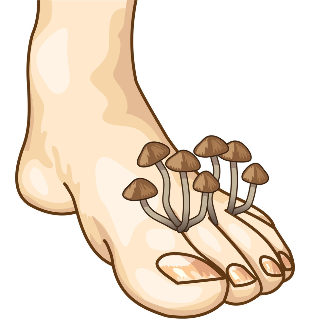
The main symptoms of the disease
Among all the skin diseases athlete's foot is the most common. That the disease may be, without taking into account the basic rules of hygiene. The cure of the fungus can sometimes be very difficult.
Each person has foot fungus it begins and develops in their own way. Here are the most common signs that can be recognized by the athlete's foot:
- while the fingers have a characteristic of crack;
- understand that it is a fungus, which can be characterized by a rash on the feet and between the toes;
- the skin is very dry, often flaky and rough;
- between your toes, the blisters, which burst to the destruction of the;
- the infection can also be transferred to adjacent areas. *
- the skin will appear red spots, which may cause considerable discomfort;
- refer to foot fungus and unpleasant odors.
Signs of the fungus, depending on the type of pathogen
This disease develops due to a variety of different types of the disease. The symptoms of the feet is different in each case.
- If the foot develops a yeast fungus, the nail will gradually becomes thinner and pulls away from the bed. The skin of the foot is hyperaemic (becomes highlighted in red).
- With the development of the fungus the nail turns yellow, covered with spots. The skin on his feet peels off, it emits the unpleasant smell. A typical symptom of this type of fungus is an increased dryness of the skin.
- The occurrence of molds, fungi of the nail plate can change its color. The skin becomes red, if it is a pathogen of pathology, has gradually transition to the whole foot. A man takes care of itching, the skin can crack. In this case, the walking is a pain, and other discomfort.
To determine the type of pathogen it is, you can only by your doctor. At home, it is possible to do so. And, if you practice self-treatment, you can only hurt yourself. It will suffer from the foot and skin fungus, it will spread more and more.
Signs of certain types of fungi
Depending on the affected area and the extent of the development, there are a number of forms of pathology. The symptoms for each are different. Awareness of the early signs of the disease, or your feet, it may be possible for the early treatment of mycosis.
- Interdigital Dermatophyte is the most common disease. She aktiviziruyutsya in the spring and in the summer, when your feet sweat the most. Between the fingers, the cracks and sores. It is possible to notice the presence of scales on their skin. The foot looks perfectly healthy. Often, the person feels itching.
- The deleted form will appear in at least the indicated level. Between your fingers has been peeling. At this stage of the disease from the leg is used a pungent smell: this occurs as a result of increased activity of the bacteria.
The disease can occur in a variety of forms. Check out its features to know how to identify fungus on the feet, and in the case of its development at the beginning of the treatment. You should be aware that in the advanced stages of the disease the nail is completely destroyed. If you want to restore, is almost impossible.
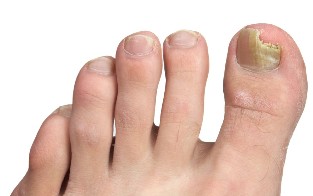
The flake type of the
This fungus, which is characterized by intense exfoliation of the epidermis. The most intense influence on the skin between the toes and the heel. The signs of the inflammatory process, they do not exist. A photo of the first signs of the foot fungus to the visible areas of hyperemia. Flaky the fungus looks like this:
- the thickened stratum corneum;
- the skin is luminous, it can become thick;
- the pattern on the skin becomes distinct;
- the fungus is gradually spreading to the toes, whole foot, and affects the nails;
- sometimes, the the epidermis occur in the lamellar scale;
- other discomfort the patient is feeling.
A chronic type of
When the fungus appears on the skin, small blisters filled with fluid. They are normally in the lateral portion of the foot. Then, they gradually move to the inner side of the fingers. How do you identify the fungus, chronic:
- the bubble is a generally solitary, but if you get a lot of them, they merge into a single large;
- if it is left untreated, the fluid in the vesicles gradually darken;
- if a blister ruptures, it appears the erosion crust.
Intertriginous type
This type of fungus is the most common. At first, the person does not feel any of the symptoms. Up to a certain point, the skin on the legs is not changed. Additional to the cracks, layering. The skin is not affected, but it can be sweat.
The incidence of athlete's foot
The characteristic symptoms of this fungal infection in the following:
- the lesion was 3. 4. of the toe;
- the skin is red and swollen;
- surrounding the lesion is a vesicle, which is to separate the layers of the skin;
- in the immediate vicinity are the pustules that bubbles.
The signs of a fungal nail
A person who may be affected, and the nails of the feet. To differentiate the disease from any of the following symptoms.
- A pronounced discoloration of the nail plate. It depends on what type of pathology of the patient, the nail acquires a variety of colors. It may be only a portion of the nail plate.
- Crumbling of the nail. It is only at an advanced stage. If the nail is completely infected, it is ruined.
- The change in the structure of the nail.
There are several types of onychomycosis — fungal nails.
- Atrophic appearance. The nail plate looks like it is very thin. It goes dark, it gets a gray-brown color. The nail is gradually peeled out of their beds. The skin under it becomes rough and loose.
- When normotroficheskie type of fungus of the feet to the plate changes its color. Her spots appear white, yellow, green and even black. The structure of the nail does not suffer.
- In hypertrophy, the number of the gradually thickens, becomes porous. The affected area is nice, and in some cases, the cause of the pain while you are walking. On the hand, that crumbles and is destroyed, without any treatment.
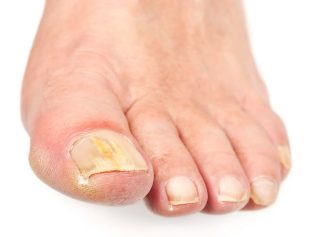
Some of the types of onychomycosis
With regard to the spread of the disease to distinguish such structures.
- Lateral onychomycosis is the most common. The free edge of the nail seems at first a small yellow spot. In the future, you can see how it becomes larger, and the nail plate thickens. While walking, the person feels discomfort. With a noticeable scent. Lateral onychomycosis is difficult to treat.
- Superficial onychomycosis is characterized by the inclusion of only the top layer of the board. It's not thick, but over time it becomes like chalk.
- The most rare form of the disease is a subungual onychomycosis. The skin is a prominent thickening in the nail fold. The nail becomes white and loses its transparency.
The risk of a group of
In fact, "catching" the fungus you are taking a risk anywhere — even at home. However, the general public is, of course, the chances are a lot higher than if you aren't careful).
Who is at risk?
More likely to catch fungus of the risks the people with the following conditions:
- Flatfoot and talipes.
- Impaired blood flow to the.
- Excessive sweating of the feet. Often, the fungus would have to get a grip of athletes and the military due to the nature of the work, they have to go in tight or uncomfortable shoes in the heat.
- The presence of corns on the feet, as well as to people with rough and thick skin on the feet.
- The low resistance of the.
- The presence of a chronic disease.
- A common injury to the skin around the nail and the nail plate itself. In this category can be attributed to the fans of the pedicures in the salon, or to people who ignore the rules of hygiene.
- Diabetes mellitus.
The general principles of the treatment of
Each treatment begins with a diagnosis. Until then, you can assign appropriate resources. Self-medication usually leads to a deterioration of the feet. A look at the most common methods of treatment.
- At the first signs of a fungal infection, apply the special nail Polish, plasters, ointments, and sprays. It may be possible to use it for a long period of time, and in accordance with the instructions provided.
- The ineffectiveness of the local one produces an antifungal medication with a complex act. It is used orally.
- Surgical removal of the affected nail.
- The laser therapy is.
- When the progressive form of the disease, which is prescribed for the management of medicines.
In order to avoid a nasty illness, observing the rules of hygiene. You should avoid the use of other people's personal hygiene (towel, Slippers). At the first signs of the disease should immediately consult a physician.
10 of the best folk remedies for nail fungus
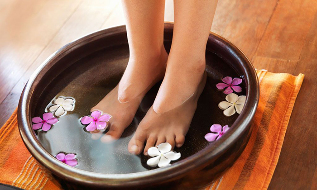
If you suspect a nail fungus at the same time as your treatment with the specialist, you can use any of the traditional methods. It is not recommended to replace medical treatments by a doctor— there is a risk to aggravate the problem and then the healing process will indeed be long and arduous.
So, what tools came to us from our grandmothers and great-grandmothers?
- The regular treatment of nails, one of the following: propolis tincture, antiseptic, tea tree oil, Apple cider vinegar.
- The foot bath.You can use sea salt (preferably without add-ons), an infusion of celandine, yarrow, Hypericum, oak bark, chamomile, calendula, etc., After a bath to apply the Polish with a lemon juice, iodine or Apple cider vinegar.
- Iron. The essence of the treatment: twice a day apply it on the damaged nails (over 20 days) with 1-2 drops of iodine. If successful, the treatment, and then go in for the treatment of 1 every 3 days.
- Kombucha. Of its infusion used as a compress. It is sufficient to impregnate the gauze, apply a compress and leave for a night out of the plastic, and the stockings. It is also possible to directly apply for a portion of tea fungus on the nails, which could be a bandage, and leave it to stand for several hours at a time. Then, pairs of legs, and used a mixture of apple cider vinegar (part 1), alcohol 96% (in 2 parts), glycerin (2 parts). To leave for the night. The course of treatment — 2 weeks.
- The garlic oil.Pour the grated garlic in the hot sunflower oil, to completely cover the garlic. All mix, cover and insist 2 days. The essence of the treatment: wetted swab into the oil applied to the painful area, put a bandage protected the top with a polythene, put on socks and leave it overnight. Of course, it is for 2 weeks.
- Vinegar.Wetted a cloth in the vinegar (9%), which is applied to the affected area, wrap with plastic, fixed with a bandage and leave it overnight. In the morning we were to be repeated.
- The barrel with the celandine. Steep your feet in a solution (3 liters of water + 1 tbsp/l of soda), wipe off the legs to the affected areas, along with your oil of celandine (look in the pharmacy). Of course, it is for 2 weeks.
- The birch-tar. Up your feet with the use of the household/Soaps (about 20 minutes), the cleaning of the feet with a pumice stone cut toenails, dry-wipe our feet, and lubricates the nail with your fingers, the birch-tar. Put your feet on the paper in 1.5 hours and read a book. Remove any excess tar with a bandage, wear cotton socks and you feet for a couple of days ago. At the end of my legs again, with khoz/the soap into the cold water. In the evening, repeat the process. Of course, it is for 2 weeks.
- Kalanchoe. Treatment: on the unpainted nail of the adhesive from the patches of the leaves of Kalanchoe them to cover the nail holes. The patches of the leaves may change on a daily basis. A course — 2-3 weeks.
Prevention of nail fungus
To protect yourself from the fungus can be a simple observance of rules of hygiene and the preventive measures to be undertaken.
Don't forget to:
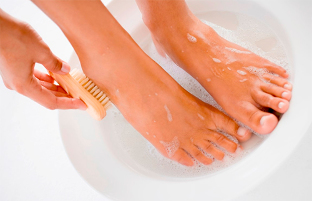
- In all the public areas (the beach, the showers, the locker room, pool, Spa-salons, etc.). wear washable Shoes. Do not walk barefoot where there is a risk of catching an infection!
- Don't wear other people's shoes (including Shoes, even better walking around in socks).
- Do not use other people's towels and manicure facilities.
- Getting out of the tub, put her feet on the Large (and often is wet, it is not the first freshness) of the Mat and your towel to pre-select it for this purpose).
- Please check back here, on my feet, and the nails of the topic of the characters of fungi. At the slightest symptoms, where they are cracking/itching in between the toes, discoloration of the nails, etc.) action to be taken. That is, to obtain the ointment, a special/lucky, etc.
- Try not to use a tight, narrow shoes and shoes made from poor quality materials.
- Regularly treat your boots inside of antiseptics.
- On the feet there is no perspiration, use of deodorants, talcum powder, etc.
- Use only cotton socks. If you want to use as a sock/stocking (production of nylon and other synthetic fibers), to make sure that you remove them at home, up to the feet of considered.
- In the heat of the to wear open shoes — for ventilation and free air exchange. Sweaty feet — ground for bacteria.
- No action for the shoes without the socks/footprints— barefoot.
- Wipe the feet dry after the bath including between your toes, where the fungus starts.
- Don't let the cracks on the feet and use a moisturizer.
- My feet mild anti-bacterial soap.
- The high risk of infection (for example, on holiday or in the pool) apply the antifungal cream, powder or spray.
- Wipe the boots, if it got wet. To put on wet shoes/boots.
- Select only to have been proven to a salon for a pedicure/manicure.
- Do not allow the ingrowth, and the nails of the volume — measures in a timely manner.






























